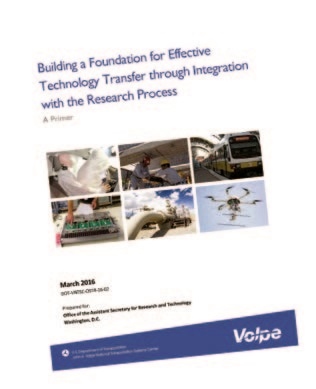Photo by Gerd Altmann/Pixaby
Transportation research is the foundation for tangible improvements in U.S. airspace, pipelines, railways, roads, and waterways—people and businesses rely on an efficient transportation system. The current highway funding legislation—the Fixing America’s Surface Transportation Act—emphasizes the importance of conducting research
that leads to real-world results.
Technology transfer (T2) is the process by which the transportation community receives and applies the results of research.
Building a Foundation for Effective Technology Transfer Through Integration with the Research Process: A Primer
 To ensure that transportation research reaches practitioners and does not languish unused, the Volpe National Transportation Systems Center recently published Building a Foundation for Effective Technology Transfer Through Integration with the Research Process: A Primer. Analysts and planners at the Volpe Center created the primer with
To ensure that transportation research reaches practitioners and does not languish unused, the Volpe National Transportation Systems Center recently published Building a Foundation for Effective Technology Transfer Through Integration with the Research Process: A Primer. Analysts and planners at the Volpe Center created the primer with
support from the U.S. Department of Transportation’s (DOT’s) Office of the Assistant Secretary for Research and Technology (OST-R).
Holistic, Proactive Approach

T2 occurs when a technology is handed over for further development or when it is put into practice and can involve a collection of activities leading to these pivotal points. A main theme of the primer is that work on T2 should take place before the research and development, while the research is underway, and after the research is finished.
The primer coalesces insights from in-depth publications on T2—many from the Transportation Research Board (TRB)—and presents a high-level plan for agencies looking to undertake technology transfer proactively. To ensure that the primer would be useful for the intended audiences, OST-R consulted with stakeholders early on, including the Federal Highway Administration, state DOTs, TRB, and academics, researchers, and practitioners across the transportation enterprise.
Transportation agency and organization leaders can use the primer as a guide for building a proactive T2 program. Successful T2 depends on a holistic approach—an organization creates a plan for technology transfer, engages stakeholders, secures resources, and executes the plan. For a larger organization, the T2 process may flow through a dedicated coordinator. For a smaller organization, a coordinator may conduct technology transfer along with other responsibilities.
Coordinator Tasks
According to the primer, a T2 coordinator pursues four key tasks:
- Understand adopters’ needs—know the problem that a technology is expected to solve and the constraints that adopters face in deciding whether to put the technology into use.
- Understand the technology, how it performs and how it may affect policy.
- Address the barriers to adoption within legal frameworks, markets, policies, and society.
- Communicate the value of a technology throughout the research and development—not only at the conclusion. The authors of the primer suggest several communications activities for each phase of research and development, including identifying champions, publishing research alerts, and conducting showcases.
Click here for detailed information on developing and executing your own T2 Plan.

